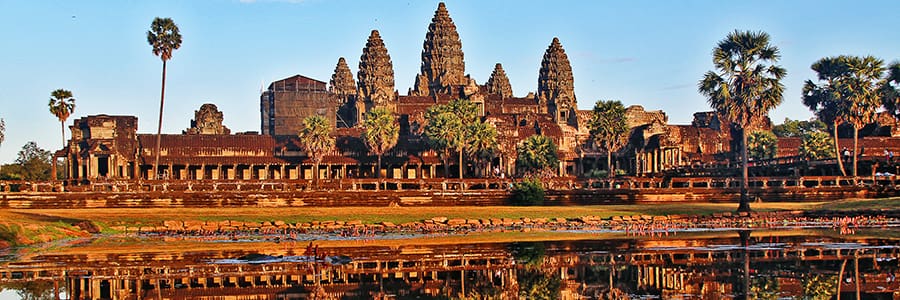
About The Tonle Sap River
Tonle means “Large Fresh Water River” or simply “Great Lake.”
Cambodia’s Tonle Sap is a seasonally-inundated freshwater lake with an attached river, the Tonle Sap River, which flows 75 miles and connects the lake with the Mekong River. The largest freshwater lake in Southeast Asia and a biodiversity hot spot, Tonle Sap was designated a UNESCO biosphere reserve in 1997.
One of the world’s most varied and productive ecosystems, with levels that rise and fall dramatically with the seasons, Tonle Sap has been a wellspring of Cambodian culture for centuries. Along the riverbanks, numerous houses, schools, churches, temples, and shops all hover above the water on stilts as boats pass by in a continuous parade. Out on the lake there are two floating villages, one with villagers of Vietnamese ancestry and the other Cambodian.
Given the change in water levels, the best time to cruise the Tonle Sap is closer to or even during the rainy season, from June to November, when the Mekong River reverses its flow into the lake, enlarging it to more than six times its normal size. Most river cruise companies offer Tonle Sap as part of a Vietnam or Mekong itinerary.
Tonle Sap River Stats
Length: 160 miles
Depth: 3 1/2 feet average
Source: Tonle Sap Lake, Cambodia
Mouth: The Mekong River near Phnom Penh, Cambodia
Locks: 0
Countries: Cambodia
Learn More About the Tonle Sap River of Southeast Asia
The Tonle Sap River is a remarkable and vital waterway that flows through the heart of Cambodia, shaping the landscape, culture, and livelihoods of the region’s people. Stretching for approximately 120 kilometers from the capital city, Phnom Penh, to the vast Tonle Sap Lake, this river is much more than just a body of water. It is a lifeline, supporting ecosystems, agriculture, and providing a means of transportation for millions of Cambodians.
Geography and Hydrology
The Tonle Sap River is an integral part of the Tonle Sap River System, which includes the Tonle Sap Lake and several other connecting rivers. This system is unique due to its flow reversal, a phenomenon that occurs annually and is linked to the monsoon rains and the Mekong River. During the dry season, the Tonle Sap River flows from the Tonle Sap Lake into the Mekong River. However, as the monsoon rains arrive, the Mekong River swells, causing the Tonle Sap River to reverse its flow, diverting water from the Mekong into the Tonle Sap Lake. This remarkable natural event dramatically increases the size of the lake, making it the largest freshwater lake in Southeast Asia.
Ecology and Biodiversity
The Tonle Sap River and the connected lake support an incredibly diverse ecosystem. The annual flow reversal brings with it nutrient-rich sediments from the Mekong, providing fertile grounds for aquatic plants and supporting a vast array of fish species. The Tonle Sap Lake alone is estimated to be home to over 200 species of fish, making it a critical source of sustenance for both rural communities and the wider Cambodian population. The region’s rich biodiversity extends beyond aquatic life. The surrounding floodplains and forests are inhabited by a wide range of bird species, including storks, eagles, and pelicans. Additionally, the Tonle Sap Biosphere Reserve, designated as a UNESCO Biosphere Reserve, safeguards the unique ecosystems of the area and promotes sustainable development.
Lifeline for Communities
The Tonle Sap River is the lifeblood of numerous communities along its banks. Its waters support a thriving fishing industry that provides employment and sustenance for countless families. Fishing is not just a source of income but also an integral part of the cultural identity of many Cambodians. The annual flood cycle of the river and lake plays a central role in the traditional agricultural practices of the region, enriching the soil and supporting rice cultivation. Beyond its economic significance, the Tonle Sap River serves as a major transportation route. For centuries, it has facilitated trade and the movement of people and goods between Phnom Penh and the Tonle Sap Lake. Even today, boats of all sizes ply its waters, connecting remote villages to urban centers and allowing access to healthcare, education, and markets.
Challenges and Conservation
Despite its importance, the Tonle Sap River faces numerous challenges. Rapid urbanization and population growth in Phnom Penh have led to increased pollution and sedimentation, threatening water quality and aquatic life. Overfishing is also a concern, as it can deplete fish stocks and disrupt the delicate balance of the ecosystem. Climate change, including altered rainfall patterns and rising temperatures, poses additional risks to the river and its surroundings. Efforts to address these challenges include conservation initiatives, improved fisheries management, and the promotion of sustainable agriculture practices. Organizations and communities are working together to find solutions that balance the needs of people and the preservation of the river’s unique ecosystem.
Cultural Significance
The Tonle Sap River has profound cultural significance in Cambodia. It has been a source of inspiration for art, literature, and folklore. The river has even played a role in the construction of ancient temples, as it was used to transport massive stone blocks to build structures like Angkor Wat. Moreover, the annual flow reversal of the Tonle Sap River is celebrated in Cambodia as the Bon Om Touk or Water Festival. This colorful and lively event draws thousands of spectators who come to witness boat races, fireworks, and other festivities that pay homage to the river and its importance to the nation.
